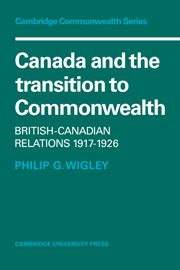Book contents
- Frontmatter
- Contents
- Abbreviations
- Preface
- Introduction
- 1 The threshold of responsibility, 1900–1916
- 2 New departures, 1917–1918
- 3 The settlement of peace, 1919
- 4 Unity and equality, 1919–1921
- 5 The centre cannot hold
- 6 Canadian diplomacy and Imperial diplomacy: 1923
- 7 From Lausanne to Locarno
- 8 The 1926 Imperial Conference: equality defined
- Conclusion
- Bibliography
- Index
2 - New departures, 1917–1918
Published online by Cambridge University Press: 26 March 2010
- Frontmatter
- Contents
- Abbreviations
- Preface
- Introduction
- 1 The threshold of responsibility, 1900–1916
- 2 New departures, 1917–1918
- 3 The settlement of peace, 1919
- 4 Unity and equality, 1919–1921
- 5 The centre cannot hold
- 6 Canadian diplomacy and Imperial diplomacy: 1923
- 7 From Lausanne to Locarno
- 8 The 1926 Imperial Conference: equality defined
- Conclusion
- Bibliography
- Index
Summary
In the closing weeks of 1916 the Asquith coalition government was brought to an end by a struggle for political power organized from within the British cabinet. The prime minister tendered his resignation, confident that he alone could reconstruct the administration; but after two days of negotiations a combination of ministers was successfully put together under the leadership of Lloyd George. Promised mixed but adequate parliamentary support the new regime took office on 7 December, with Lloyd George as prime minister. This second change of government since the start of the war was ostensibly not unlike the first: a shuffle and reallocation of portfolios without recourse to a general election. In several distinct ways, however, it was to mark a deep transformation in the structure and style of Britain's wartime machinery of government.
In the first place more than a simple exchange of ministers was involved. Lloyd George excepted, the Liberal leaders with whom Asquith for two years and more had endeavoured to command the war effort were gone, pushed aside in what amounted to a fundamental shift in political and public opinion towards the conduct of the war. Asquith's attempt to accommodate wartime government to the principles of liberal political philosophy was at an end, any remaining justification for it having been eradicated by the disastrous military operations of the 1916 campaigns. From inside the cabinet, from parliament and beyond, a consensus emerged that was prepared to tolerate social and economic restraints in the cause of a more efficient prosecution of the war – and under Lloyd George's supervision, the chance to consolidate and reinforce this desperate sense of purpose was willingly seized by the Conservatives.
- Type
- Chapter
- Information
- Canada and the Transition to CommonwealthBritish-Canadian Relations 1917–1926, pp. 27 - 66Publisher: Cambridge University PressPrint publication year: 1977

